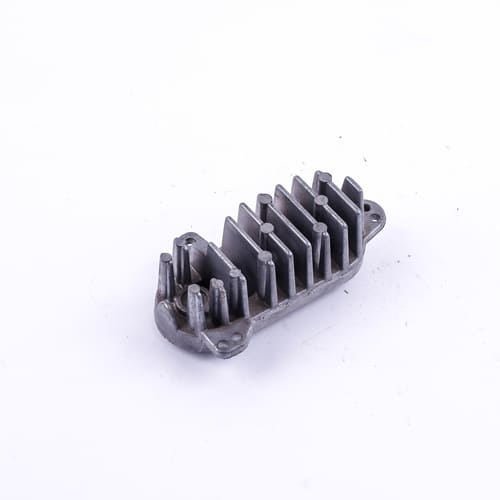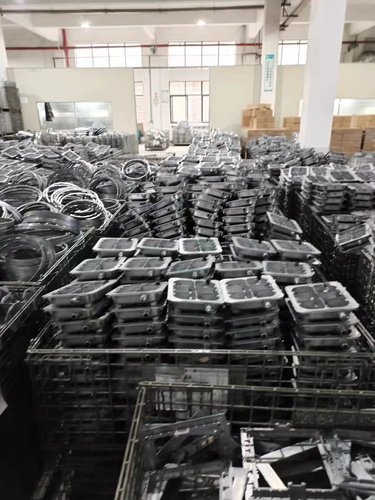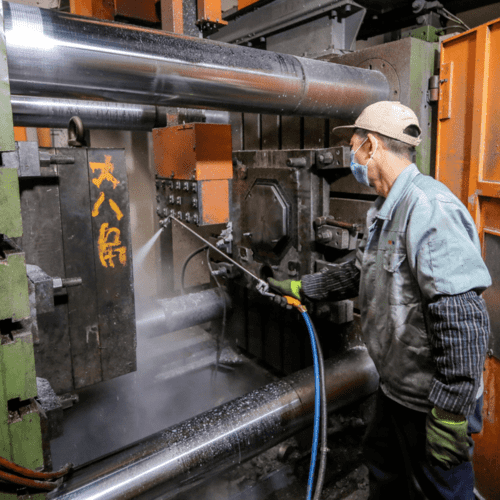Introduction
Metals are widely used in casting. Casting involves pouring molten metal into a mold, and then allowing it to solidify. In casting, metals are not used in their raw state but are rather heated in a heating furnace till they melt.
Also, in casting, metals such as steel or cast iron are used in making permanent molds. This is because of their (metals) high strength, heat resistance and low porosity.
There are various metals you can use in casting. In this article, we would consider these various metals. Okay so, let’s dive in.
Types of metals
There are broadly two types of metals, which are ferrous and non-ferrous metals.
(a.) Ferrous metals: These are metals that contain iron. If a metal has iron as its first or second most dominant element, such metal is a ferrous metal. Their iron composition makes them prone to corrosion when exposed to moisture.
To determine whether a metal is a ferrous metal, you need to measure the valence. If its valence is -12, then it’s a ferrous metal.
Other than iron, different ferrous metals contain other alloying elements such as chromium, nickel, manganese, vanadium, etc.

So, various ferrous metals can have varying characteristics, depending on their alloying elements.
For example, cast iron and low-carbon steel have varying features (despite both being ferrous metals). The former is soft and brittle, while the latter is soft and ductile because of its low carbon content.
Ferrous metals are recyclable, durable and have high magnetic properties. Also, they have high tensile strength, hardness, and good electrical conductivity.
(b.) Non-ferrous metals: These metals contain little or no iron contents, and this makes them corrosion-resistant. They don’t show the red flaky metals that ferrous metals show. They are also lightweight, impact-resistant and non-magnetic.
Non-ferrous metals have low density and good thermal/electrical conductivity. They also have strong performance under temperature. Because they are not magnetic, they are suitable for manufacturing cast parts for the electrical/electronics industry.

Non-ferrous metals are ordinarily gotten from minerals such as silicates, sulphides and carbonates. They are refined through electrolysis.
Pure metals are generally non-ferrous, except iron
Can you use ferrous and non-ferrous metals in casting?
Yes, you can use both ferrous and non-ferrous metals in casting. However, because non-ferrous metals are not prone to corrosion and rust, they are more commonly used than ferrous metals.
Both ferrous and non-ferrous metals have their perks. For example, if you want lightweight cast parts, consider using non-ferrous metals.
This is because ferrous metals are heavier than non-ferrous metals. Also, for high malleability, consider using non-ferrous metals.

On the other hand, ferrous metals are more cost-effective than non-ferrous metals. If you are on a low budget, consider using ferrous scrap metals.
Also, if your project requires very strong cast parts with high strength and durability, consider using ferrous metals.
It is important to note that there are different metals under ferrous and non-ferrous metals. Now, let’s consider some of these metals individually.
Ferrous metals used in casting
These include:
• Cast iron: Cast irons have a minimum of 2% carbon and various quantities of silicon, sulfur, manganese and phosphorus. They have excellent machinability and vibration damping; though they have low tensile strength.
The different types of cast irons are Grey iron, White iron, Ductile iron, and Malleable iron.
• Grey iron: Grey irons contain 95% iron and 1-3% silicon. They have excellent castability, machining and damping capacity.
They have graphite microstructure and good galling and wear resistance. This is because the graphite flakes lubricate themselves.

Also, they have low tensile strength and ductility. They have very little impact and shock resistance.
Note that grey irons have less solidification shrinkage than other cast irons.
• Malleable iron: To manufacture malleable iron, you need to cast the ‘white iron’ and then apply a special annealing treatment. This would make the metal lose its brittleness and change the internal microstructure.
Malleable irons have similar composition to white irons, except that they contain more iron and silicon.
Also, malleable irons have graphite modules that are not spherical as they are in ductile iron. They have great ductility and excellent surface hardening.

• Carbon steel: Carbon steel contain other alloying elements in little quantity. These elements include sulphur, manganese, phosphorus, silicon, etc.
The elements are in such low quantities that they don’t alter the inherent properties of carbon steel. There are three different categories of carbon steel, which are:
— Low-carbon steel: They contain 0.05-0.25% carbon. They have very low tensile strength than other steel and are very soft. They are not suitable for heat treatment.
— Medium carbon steel: They contain 0.25-0.6% carbon. They are stronger than low-carbon steel. Because they have more carbon and manganese, they can be tempered and quenched.
— High-carbon steel: They contain 0.6-1.0% carbon. They are the strongest among the non-alloyed steels. They are stronger than both low and medium-carbon steel.
Non-ferrous metals used in casting
These include:
• Aluminium: This is the third most abundant metal in the earth’s crust. They constitute about 8% of the earth’s crust. Aluminium is gotten from bauxite (aluminium ore).
The bauxite would be purified to produce aluminium oxide. Then, aluminium would be extracted from the oxide by electrolysis.
They are lightweight, durable and corrosion-resistant. They are resistant to weather, common atmospheric gases and a wide range of liquids.
They have good EMI shielding properties and high elasticity. There are various aluminium alloys you can use in casting. These include:

–A380: A380 aluminium alloys are one of the commonest aluminium alloys used in casting. They are strong at high temperatures, lightweight, and have excellent physical and mechanical properties. A380 aluminium alloys have excellent fluidity and pressure tightness.
–A383: A383 aluminium alloys are usually used to manufacture intricate components requiring very specific die-filling characteristics. They have higher strength at high temperatures.
–A413: They do not crack and have good pressure tightness. They contain an appropriate balance of both physical and mechanical properties.
–A360: They have higher strength at high temperatures, higher corrosion resistance, and better ductility. Because they are hard to cast, they are not usually used in casting.
• Zinc: You can get this metal from zinc ores such as calamine and zinc blenders. They are covered by dull basic zinc carbonate in moist air. They are fairly reactive metal that combines with oxygen and other metals.

Zincs have an atomic number of 30 and a mass of 65.38. They are the 23rd most abundant element in the earth’s crust. They have a low melting point;
they melt at 787.2°F. They require less pressure during die-casting, thereby simplifying the casting process. They have a tensile strength of 700-1400kg/cm².
They have a higher density and weight. They can be used to create thin-walled cast parts and decorative elements. They’re one of the toughest alloys and are highly impact-resistant.
Zincs have high electrical conductivity, and this makes them suitable for applications such as heat sinks and electrical components.

They are less abrasive and have a specific gravity of 7.0. They are ideal for miniaturised die-casts parts.
Also, during casting, zincs have a significantly long die life. This helps in saving production costs.
• Brass: Brass are mainly made of copper and zinc. They contain 33% zinc and 67% copper. They also contain little proportions of some elements such as phosphorus, arsenic, lead, manganese, aluminium, silicon, etc.
Brass have a density of around 0.303lb/cubic inch. They have no magnetic properties. They also have a dimensional accuracy of 0.1mm, and a wall thickness of 0.75mm. Brass has excellent heat and electrical conductivity.

They have extreme abrasion-and-wear resistance for cast-in-steel components. Because of their less friction, brass cast parts are suitable for the furniture industry.
• Magnesium: They are produced from water, brines and magnesium. They have a silver-white colour that can easily ignite. They are the eighth most abundant element.
They provide an excellent EM-RFI shield. They have high impact resistance and are one-third less dense than aluminium.
They are fully recyclable and are suitable for casting thin-walled and complex parts. They melt at lower temperature and are easy to machine. They are highly reactive and can retain strength at high temperatures.

Magnesium is 38% lighter than aluminium and 75% lighter than steel. They have great energy-absorbing capabilities.
The various magnesium alloys you can use in casting include:
–AZ91D: AZ91D magnesium alloys are the commonest magnesium alloy for die-casting. They are mostly used to manufacture hard mechanical components.
–AM60B: AM60B magnesium alloys have good energy absorbing properties, excellent ductility, castability and strength.
–AM50: They have a lower aluminium content than AM60. They also have a high ductility at a slightly reduced strength.
Note that:
Plastic injection molding has emerged as an alternative to metal casting. There are several attendant benefits in casting with plastics.
Plastic cast parts are lighter than metal cast parts. Some modern plastics are stronger than steel. Some polymers can withstand even the most potent acids and bases. Also, you can use additives to strengthen plastic cast parts.

It is cheaper to construct and design parts manufactured through injection molding. You can also easily add your preferred colour to plastic melts, rather than painting. This reduces the cost of casting.
Conclusion
In this article, we noted that there are various metals used in casting. The two broad types of metals are ferrous and non-ferrous, and there are different metals under each of these broad types. We explained the features of each metal and we briefly pointed out the emergence of plastic injection molding as an alternative to metal casting.








